We’re going to break down search intent and learn the best practices for making sure Google understands when they should show your content in SERPs. Let’s jump right in.
Table of Contents
What Is Search Intent?
Search Intent, or “User Intent,” is the objective a user wants to achieve when searching for something. The search engine will interpret the keyword(s) in a search query to identify the user’s intent. Then, it will do its best to match the query with relevant, quality content in response.
In other words, the content displayed on Search Engine Results Pages (SERPs) reflects the search engine’s interpretation of what a user is looking for.
Let’s take a look at the common types of user intent, how Google understands intent, and tips for making sure your content targets the right search intent.
Common Types of User Intent:
In the SEO world, user intent is almost entirely summarized in 4 categories:
Informational Intent: Users seek information or answers to questions.
Commercial Intent: Users are in the research phase before making a purchase.
Navigational Intent: Users are looking for a specific website or page.
Transactional Intent: Users intend to make a purchase or take a specific action.
When you set out to create content, you should always ask yourself what type of intent your content would match. In other words, you should get clear on whether you are creating informational content (a how-to post on your blog), commercial content (a free trial offer for a program you sell), navigational content (an about page), or transactional content (a product page).
We’ll dive deeper into tips for matching content to user intent later on. In the next section, we will see how Google ties all of these things together to deliver content in response to a search query.
How Google Interprets Search Queries to Determine User Intent in 2023
To start figuring out what content should be served in search results, Google first does its best to determine the possible meaning of the search query. To do this, Google relies on data it has accumulated over many years about what a particular keyword or key phrase means. In other words, Google has predetermined meanings for a lot of words.
For example, Google understands the phrase “near me” to mean someone wants a proximal, physical answer. Another example is the phrase “Best” which Google has predetermined to mean the user is looking for a list, ranking, or comparison-type content.
Google also understands that queries can have more than one meaning. For example, the query [Amazon] might refer to the online retailer or the Amazon Rainforest. If a user includes the keyword “Rainforest” in their search, they will get appropriate results.

Google’s current approach to user intent in 2023 involves categorizing search queries into specific categories to determine the most relevant content for SERPs. Let’s break down these queries with practical examples for understanding:
Search Query Categories:
These are the current categories Google uses to classify search queries based on the keywords they contain:
- Know Queries:
- Definition: Queries seeking general information or exploration.
- Example: “Nutritional value of beef.”
- Know Simple Queries:
- Definition: Specific queries seeking a straightforward answer.
- Example: “Temperature for rare roast beef.”
- Do Queries:
- Definition: Queries aiming to accomplish a goal or engage in an activity.
- Example: “Buy organic beef online”
- Website Queries:
- Definition: Queries focused on finding a specific website or webpage.
- Example: “Beef recipes site:foodnetwork.com.”
- Visit-in-Person Queries:
- Definition: Queries with the intent to find local businesses or places.
- Example: “Butcher shops near me.”
Queries with Multiple User Intents:
It’s also important to know that Google can understand search queries with multiple intents. To deliver results, Google may serve a mix of content in SERPs as well as content that matches multiple intents.
Once Google has determined the possible meaning behind the search query a user is using, it needs to figure out what to deliver in response to meet the user’s goal. Let’s look at that next.
Delivering Relevant Content: How Google Curates SERPs to Match User Intent
Google employs a sophisticated process to figure out what content to deliver in SERPs, based on the meaning it determines from the search query and the desired goal (the user intent) behind the search. Both the user and Google play a role in this, as shown in the flowchart below:
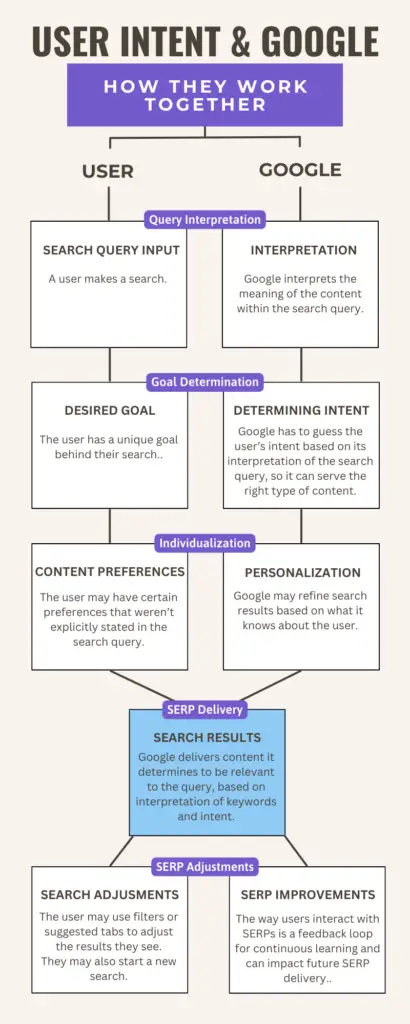
Google will use its categorizations from previous steps to direct the algorithm to find content that matches the user intent classification.
This is critically important for website owners and marketers to understand because this is where Google determines if content like yours is relevant and worth delivering in response to a search query.
Let’s look at some examples of this in action.
Transactional Content
Example: A user searching “Buy grass-fed beef” is likely looking to do something; namely, buy the thing. As such, the algorithm will look to deliver content like product pages and shopping listings.
Example SERP display for transactional intent:
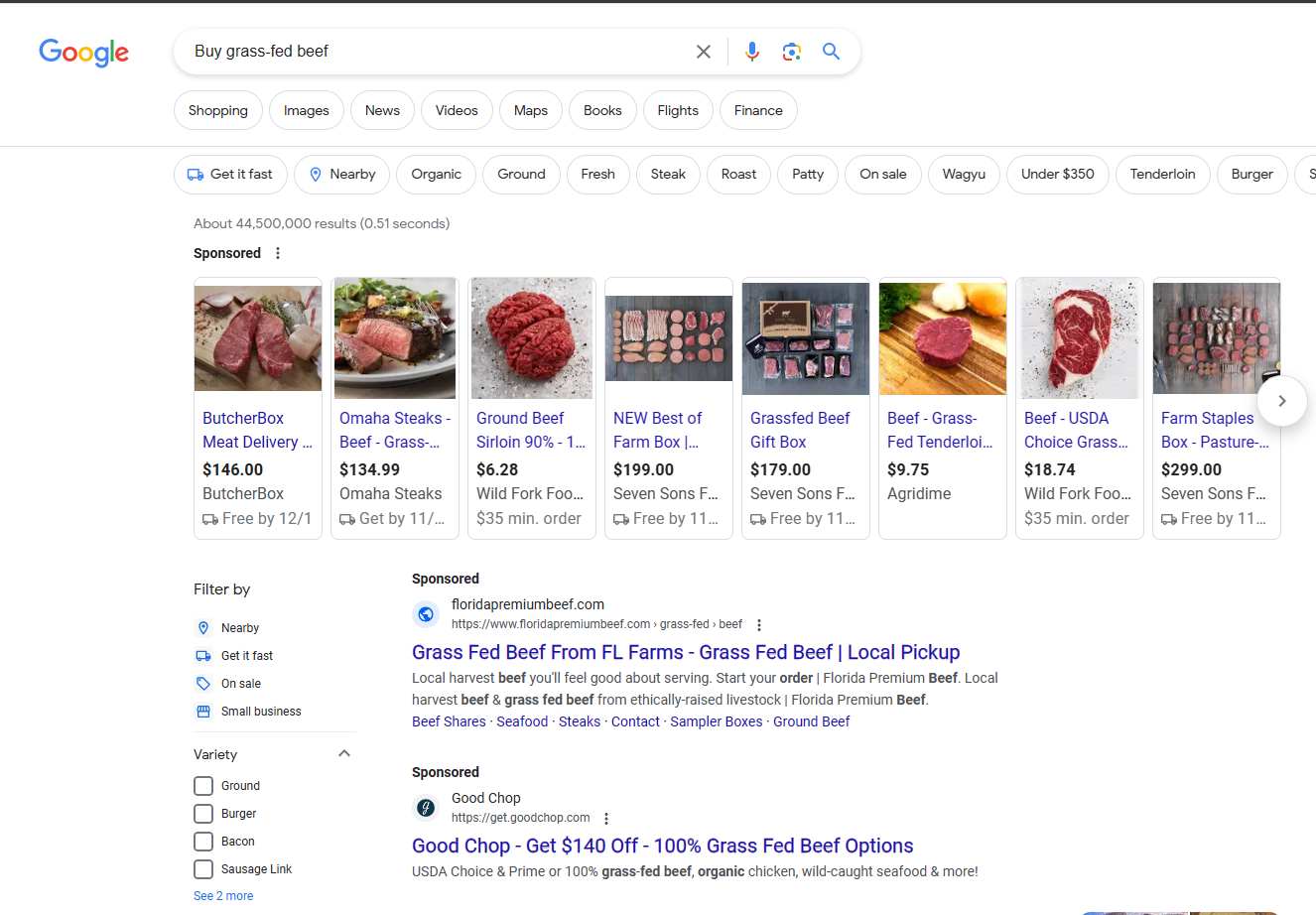
Informational Content
Example: A query like “How to cut a whole beef tenderloin” suggests a desire to know a process. Process keywords indicate a user might find a list of ordered steps or how-to videos and diagrams helpful.
Example SERP display for informational intent:
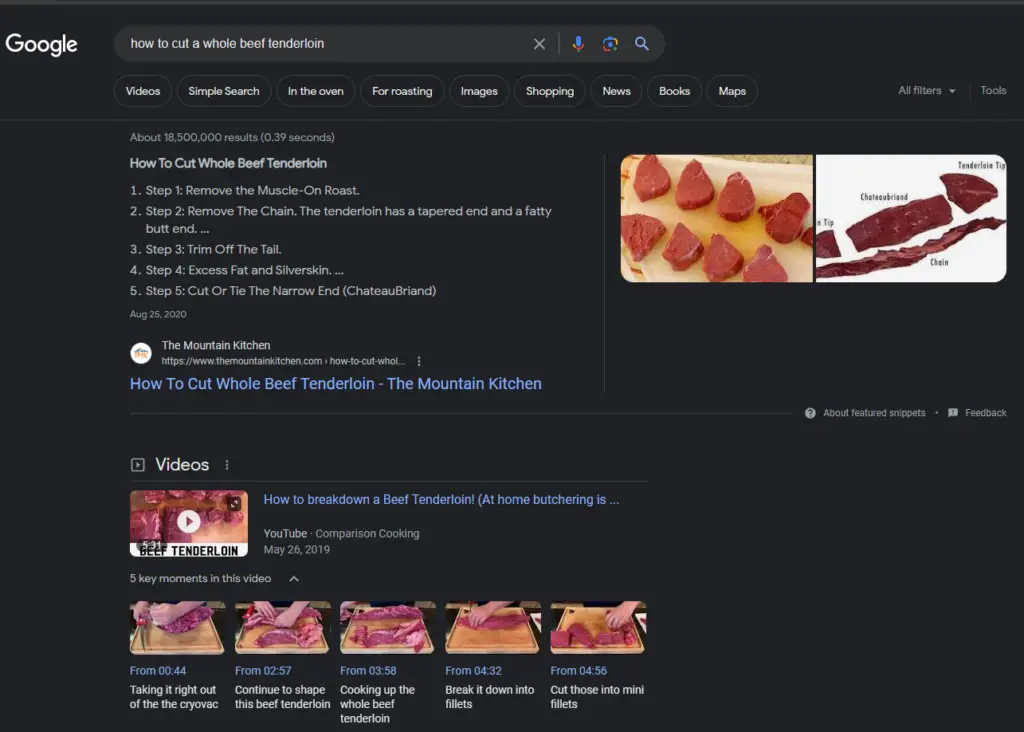
Navigational Content
Example: A user searching “Serious Eats Roast Beef” probably wants to navigate directly to the Serious Eats website for their roast beef content. Google will want to deliver results from Serious Eats.
Keywords with a brand name in them are called branded keywords (and you should definitely consider using them!).
Example SERP display for navigational content:
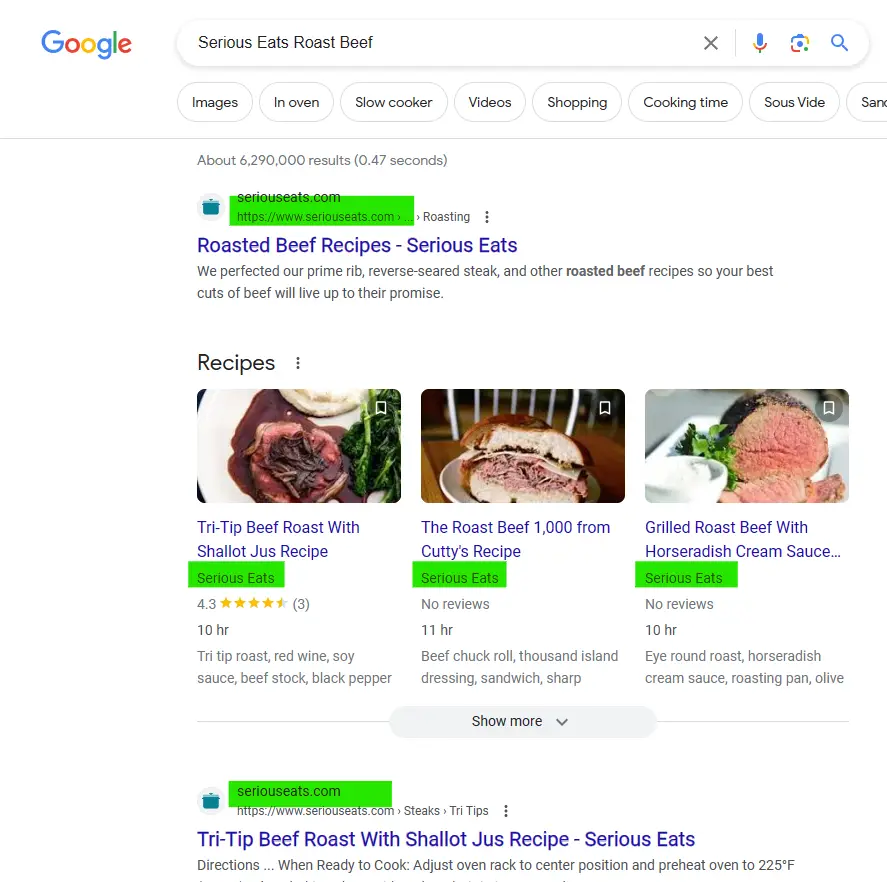
Commercial Content
Example: A query such as “Best beef brands 2023” indicates a commercial intent, potentially looking for product reviews before making a purchase. Google will look for reviews, lists, and product comparison tables to help people learn more about what and who they can buy from. Commercial intent is often interpreted to have informational intent and/or transactional intent, as well.
Example SERP display for Commercial Intent:
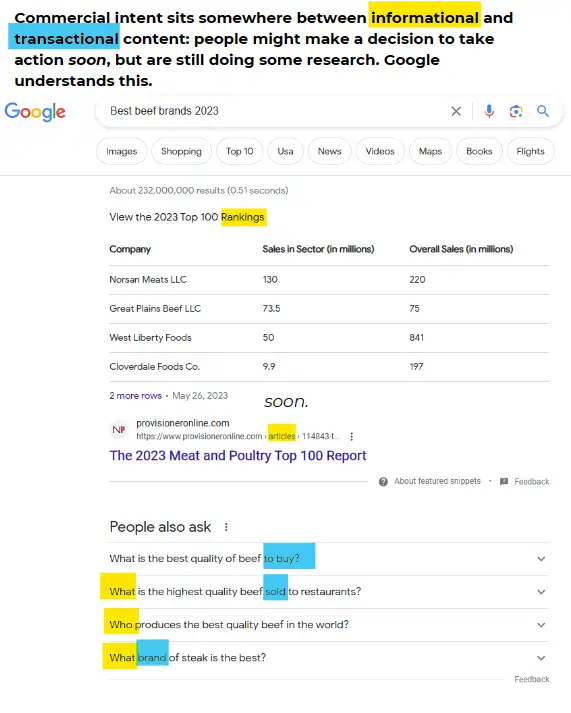
The way Google interprets search queries and determines search intent is flexible and fluid, and search queries don’t need to fit in one box.
You should always be aware of how Google interprets a keyword you wish to target – Creating informational content for a keyword Google views as having transactional intent probably means your content won’t be considered a good match for SERP displays for that keyword.
With this understanding, let’s dive into the journey from a user’s search query to the Search Engine Results Page (SERP).
The Journey for Search Query to Search Results
Let’s tie everything we’ve looked at together so far by mapping out the journey from search query to search results. Let’s connect the dots and explore the journey from a search query to the displayed results. Remember, this is a dynamic process shaped by user interactions, and the content Google presents in SERPs evolves based on how users engage with previous results.
- Search Query: A user enters a query, for instance, “best ways to cook beef.”
- Google’s Interpretation: Google interprets the query, categorizing it as a “Know” type with Informational intent.
- Algorithmic Processing: Algorithms process the query against indexed content, looking for informational content that is high-quality and relates to cooking techniques for beef.
- Search Results: The SERP displays results tailored to the informational intent, such as recipes, cooking methods, and tips for preparing beef.
- User Interaction: The user interacts with the results, scrolling through Google’s search features, clicking links, and/or interacting with on-page content. The user may end their search or navigate back to the search results page to keep scrolling or start a new search query.
- Adaptation to User Behavior: Google learns from user interactions with search results to continuously refine and enhance future SERPs for the same and related queries.

Best Practices for Search Intent Optimization
Before you create new content, you should give some thought to how keywords, content structure, and user intent will all come together. Your content will be interpreted by search engines and users, so you want to create content with both in mind.
General Approach:
How much time you put into content planning may vary, but you should always make a basic effort to understand the user intent your content is meant to match. A simple way to do this is to test your keyword and example content title out in a Google search. The SERPs for your target keyword/content title will show you what Google is already delivering for that specific search query. If the search results match your intent, you can take inspiration from existing results to optimize your content for similar success. If the results differ from your expectations, it signals that Google interprets your keyword differently, and you can adjust your approach before you start producing the content.
Optimization Tips:
Keyword Analysis:
- Test your target keyword with a search query and evaluate whether the results indicate informational, transactional, navigational, and/or commercial intent.
- Explore variations of your keyword using Google’s auto-suggest and People Also Ask for free keyword ideas.
SERP Analysis (Do this to plan content after figuring out keyword intent):
- Look at what type of content Google deems relevant based on top-ranking results: Videos? Images? Product Listings? Blog Articles?
- Analyze what ranks in the top 10; identify common themes for content types.
- Examine who ranks for your target keyword. Try paying attention to who ranks 4th and 5th for highly competitive searches – you have a greater opportunity to outrank them than Number 1.
User Experience (During and After Creating Content)
- Ensure your content aligns with the user intent suggested by the keyword.
- Use clear titles, avoid fluff, and refrain from keyword stuffing.
- Communicate with a 5th-grade reading level and use visuals to explain complex topics.
- Include a table of contents in written content and chapter markers in video and audio content for easy navigation.
- Use internal links to other content on related topics (don’t try to cram everything about a related topic in one article: it will confuse users and search engines).
- Make sure your content delivers the outcome users are looking for.
Continued Optimization & Updates:
Improve your content over time by adding relevant media, removing outdated information, and updating internal links. Periodically check keyword SERPs for significant changes in how Google interprets pages or the featured content type.
Key Takeaways
In this guide, we’ve covered:
- How search intent works
- How Google matches user intent with relevant content
- Example SERPs for each type of user intent
- How you can enhance SEO and content quality through best practices.
Some of these concepts are things I took for granted and didn’t know proper terminology for for quite some time. Learning by doing has always helped me grasp a concept, so if you’d like to check out free and simple tutorials and how-to content, make sure you subscribe to my YouTube Channel to keep learning.

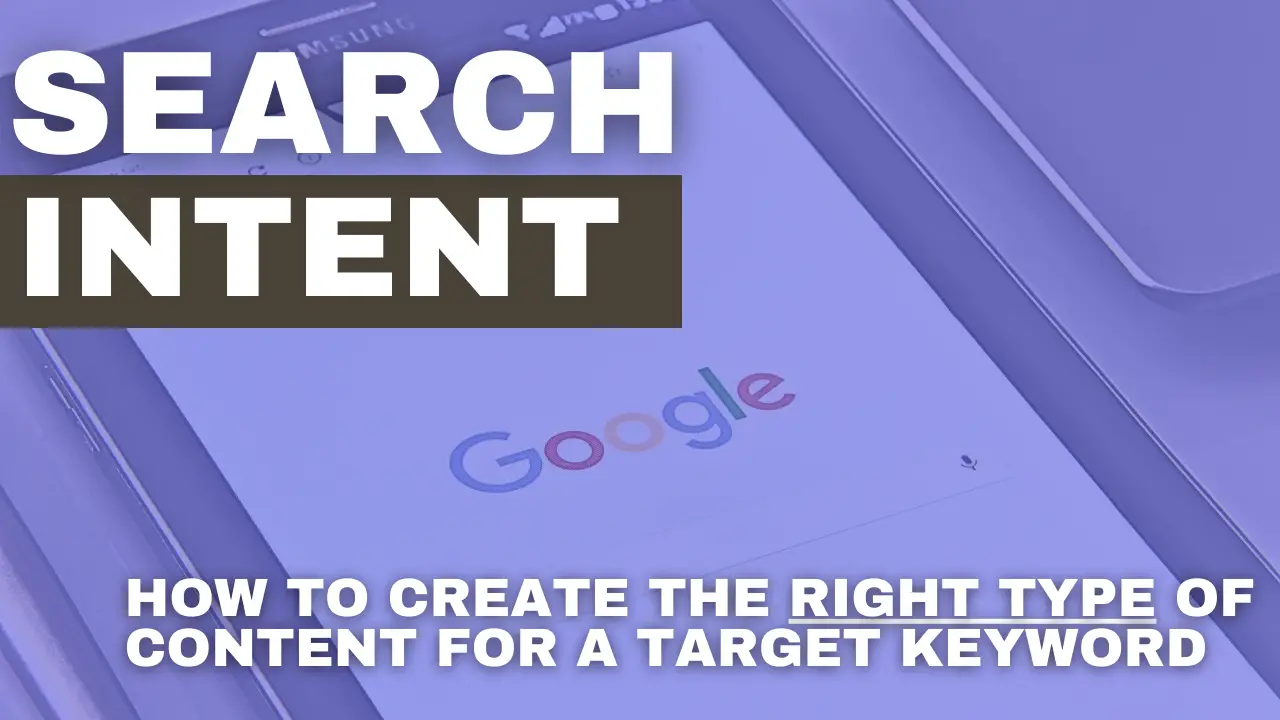
Thank you, I have just been searching for information approximately this topic for a while and yours is the best I have found out so far. However, what in regards to the bottom line? Are you certain concerning the supply?
Saved as a favorite, I really like your site!